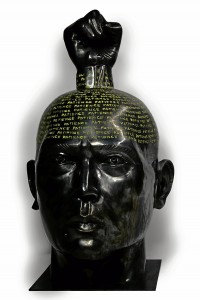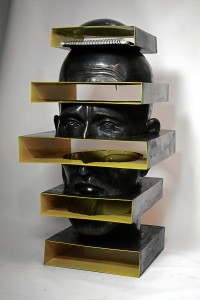
A Moro legend to hang on the wall, sculptural receptacles that offer food for thought, and furniture artfully done in handsome wood beckon people to see “Triangulo,” an exhibit of works by National Artist Abdulmari Asia Imao, his son Juan Sajid, and Claude Tayag, at The Gallery of Greenbelt 5.

Melding art and function, the exhibit features pieces by the trio which are drawing design and art admirers.
Moro heritage takes center stage in Abdul Imao’s work. The ones on view will, in fact, be part of a book that honors him as the first Moro National Artist.
The sarimanok of Muslim lore has long been the elder Imao’s favored subject; it’s a popular genre perhaps because it is said to augur good fortune. With colors as bright as the vintas of Mindanao, Abdul Imao’s art is a testament to the vibrancy of southern Philippine culture.
He preserves in his paintings and brass sculptures the Maranao okir pattern. A staple on fabric and as embellishments on sword hilts or blades and the beams of ancient tribe leader’s dwellings, the vine-and-leaf motif is an intricate mix of angles and curves.

Tell-tale signs
Complementary curvilinear and angular constructions are also consistent in a Claude Tayag creation, tell-tale signs of his architectural training. Known for his wooden “art furniture,” his offerings here include raw slabs and tree trunks fused with angled or shaped components.
An example is “Table Offering.” Its top resembles either a scarred, uneven terrain or a slab of grilled meat (maybe an amusing reference to Claude’s culinary leanings); its back brace is like thick black licorice. In contrast, its front legs consist of smooth slim poles and its base two angular bars that form a “V.”

His seeming weave of undulating vertical wood strips dotted with random circular openings is a free-standing divider he calls “Peeping Tom’s Wall.”
Evident in both pieces is the artist’s penchant for tempering the rustic feel of wood with modern touches.
Classical and contemporary
Classical merges with the contemporary in Juan Sajid Imao’s hammered brass sculptures which are treated with patina and paint. His 3D self-portrait shows a man’s head that sports a mole below the right side of the lips. A clenched fist seems to have broken through the bald top.
From above the brows all the way up to the wrist, the word patience is etched in block letters over and over; painted bright, almost fluorescent yellow. The fist resembles a topknot, revealing how the artist wills himself to work with patience until full artistic fruition is achieved.
Among the younger Imao’s pieces is a sculpture that doubles as a book or magazine shelf. Its title, “Impluwensiya” (Influence), implies how, by some osmotic process, our mind is directed by what we read. The newspaper holder, “Outside My World,” is again a bald head with round rings on top.
Functionality in Sajid’s works sums up his artistry, which combines prowess, profundity and humor all at the same time.
For inquiries regarding “Triangulo,” call Rita Orr at 9329510, 9329511, 0917-3363769; or Zaldy Zerances at 0917-6635348.
For comments, e-mail author at majorday@gmail.com.

